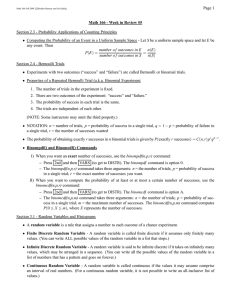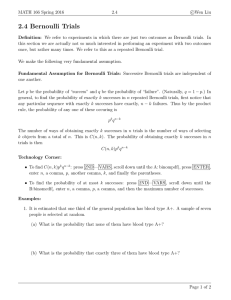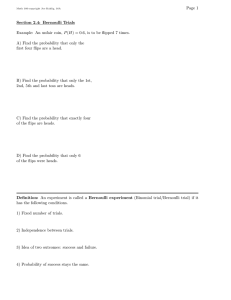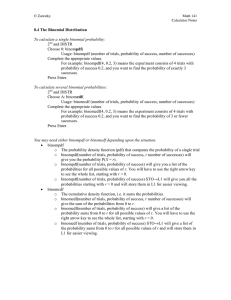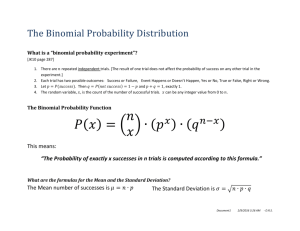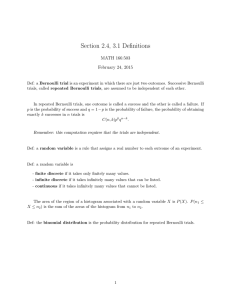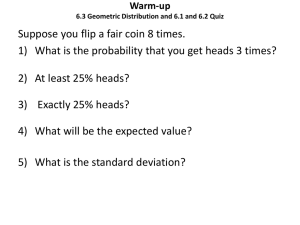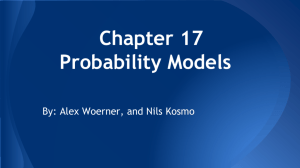Document 10496128
advertisement
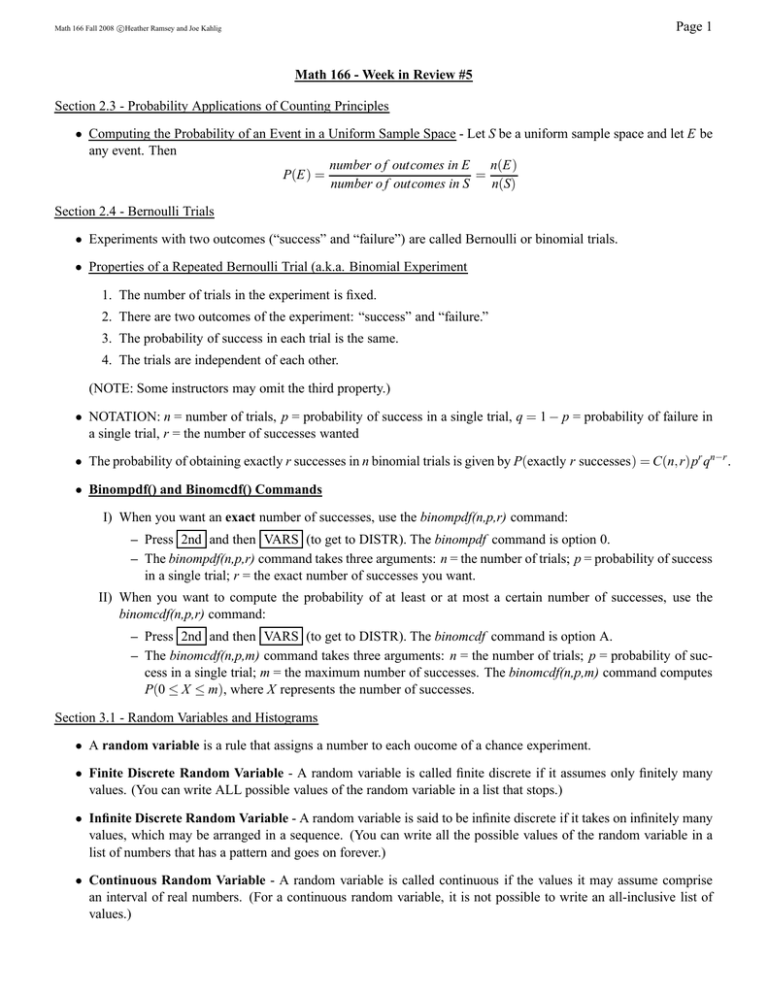
Page 1 c Math 166 Fall 2008 Heather Ramsey and Joe Kahlig Math 166 - Week in Review #5 Section 2.3 - Probability Applications of Counting Principles • Computing the Probability of an Event in a Uniform Sample Space - Let S be a uniform sample space and let E be any event. Then n(E) number o f outcomes in E = P(E) = number o f outcomes in S n(S) Section 2.4 - Bernoulli Trials • Experiments with two outcomes (“success” and “failure”) are called Bernoulli or binomial trials. • Properties of a Repeated Bernoulli Trial (a.k.a. Binomial Experiment 1. The number of trials in the experiment is fixed. 2. There are two outcomes of the experiment: “success” and “failure.” 3. The probability of success in each trial is the same. 4. The trials are independent of each other. (NOTE: Some instructors may omit the third property.) • NOTATION: n = number of trials, p = probability of success in a single trial, q = 1 − p = probability of failure in a single trial, r = the number of successes wanted • The probability of obtaining exactly r successes in n binomial trials is given by P(exactly r successes) = C(n, r)pr qn−r . • Binompdf() and Binomcdf() Commands I) When you want an exact number of successes, use the binompdf(n,p,r) command: – Press 2nd and then VARS (to get to DISTR). The binompdf command is option 0. – The binompdf(n,p,r) command takes three arguments: n = the number of trials; p = probability of success in a single trial; r = the exact number of successes you want. II) When you want to compute the probability of at least or at most a certain number of successes, use the binomcdf(n,p,r) command: – Press 2nd and then VARS (to get to DISTR). The binomcdf command is option A. – The binomcdf(n,p,m) command takes three arguments: n = the number of trials; p = probability of success in a single trial; m = the maximum number of successes. The binomcdf(n,p,m) command computes P(0 ≤ X ≤ m), where X represents the number of successes. Section 3.1 - Random Variables and Histograms • A random variable is a rule that assigns a number to each oucome of a chance experiment. • Finite Discrete Random Variable - A random variable is called finite discrete if it assumes only finitely many values. (You can write ALL possible values of the random variable in a list that stops.) • Infinite Discrete Random Variable - A random variable is said to be infinite discrete if it takes on infinitely many values, which may be arranged in a sequence. (You can write all the possible values of the random variable in a list of numbers that has a pattern and goes on forever.) • Continuous Random Variable - A random variable is called continuous if the values it may assume comprise an interval of real numbers. (For a continuous random variable, it is not possible to write an all-inclusive list of values.) c Math 166 Fall 2008 Heather Ramsey and Joe Kahlig Page 2 • Histogram - a graphical representation of a probability distribution of a random variable. Steps for Making a Histogram 1. Locate the values of the random variable on the number line. 2. Centered above each value of the random variable, make a rectangle with width 1 and height equal to the probability associated with that value of the random variable. 1. A box contains 2 red marbles, 8 yellow marbles, 6 red gumballs, 5 yellow gumballs, and 3 blue jawbreakers. If a sample of 5 objects is randomly chosen from the box (without replacement), what is the probability that (a) exactly 3 yellow marbles are chosen? (b) exactly 3 red gumballs and exactly 2 yellow objects are chosen? (c) exactly 4 yellow marbles or exactly 1 blue jawbreaker is chosen? (d) at least 1 yellow marble is chosen? 2. Three married couples go to the movies. If these 6 people randomly sit in 6 adjacent chairs, what is the probability that each person sits next to his or her spouse (i.e., married couples sit together)? 3. Determine if each of the following is a repeated Bernoulli trial. If it is not, explain why. (a) Cast a fair die until a 3 lands up. (b) A box contains 20 clocks, 10% of which are defective. A sample of 5 clocks is selected one at a time without replacement and tested for quality control purposes. (c) Draw 6 cards one at a time with replacement and record the suit of each card drawn. (d) Analyze the composition of a 4-child family in which each child was born at a different time (no twins, triplets, etc.). 4. License plates in a certain state are made with 6 symbols using letters and digits. If a person is given a new license plate, what is the probability that the license plate (a) has 3 letters followed by 3 digits? (b) starts with the letter A or B and ends in an odd digit? (c) has no letter or digit repeated? 5. Consider the composition of an 8-child family in which each child was born at a different time. (a) What is the probability that exactly 2 of the children are boys? (b) What is the probability that at most 2 of the children are boys? (c) What is the probability that at least 5 of the children are girls? (d) What is the probability that at least 3 but no more than 6 of the children are girls? 6. Acme, Inc. ships lightbulbs in lots of 50. Before each lot is shipped, a sample of 8 lightbulbs is selected from the lot for testing. If any of the bulbs is defective, the entire lot is rejected. What is the probability that a lot containing 3 defective lightbulbs will still get shipped? 7. In a group of 7 people, what is the probability that at least 2 of the people in this group were born in the same week? (There are 52 weeks in a year. Assume that all weeks are equally likely.) 8. Harry, Sally, Bob, Fred, Ann, Sue, and Carlos go to the movies and randomly sit in seven adjacent chairs. What is the probability that c Math 166 Fall 2008 Heather Ramsey and Joe Kahlig Page 3 (a) Harry and Sally sit on opposite ends from each other? (b) Sally, Fred, and Ann sits in the middle 3 chairs? (c) Sally, Fred, and Ann sit together in 3 consecutive chairs? (d) Sally, Fred, and Ann do not sit together in 3 consecutive chairs? 9. Classify each of the following random variables as either finite discrete, infinite discrete, or continuous, and give the values of the random variable. (a) Cast a die until a 5 lands up. Let X denote the number of throws in one trial of the experiment. (b) A farmer plants 10 watermelon seeds. Let X denote the number of the seeds that sprout. (c) Let X denote the weight of my cat Mouse in pounds. (d) Let X denote the number of minutes that a person waits in line at a grocery store check-out lane during the 5 o’clock hour. (e) A bag contains 3 red blocks, 2 green blocks, and 7 purple blocks. Blocks are drawn one at a time with replacement until a green block is drawn. Let X denote the number of blocks drawn in one trial of this experiment. (f) Let X denote the number of queens in a 10-card hand that has been chosen from a standard deck of 52 playing cards. (g) A class consists of 2 freshmen, 5 sophomores, 9 juniors and 10 seniors. Students are selected one at a time at random from this class until a sophomore is found. No student gets selected more than once. Let X denote the number of students selected in one trial of this experiment. 10. A box contains 2 pens, 3 pencils, and 5 highlighters. A sample of 6 items is drawn from the box without replacement. Let the random variable X denote the number of pencils in the sample. (a) What type of random variable is X , and what are the possible values of X ? (b) Find the probability distribution of X . (c) Draw a histogram representing the probability distribution of X . (d) Find P(X = 2). (e) Find P(X < 3). 11. A health inspector has determined that 12% of all restaurants in a certain city are in violation of the health code. If 5 restaurants are selected at random for inspection, what is the probability that (a) exactly 3 of the restaurants fail the inspection? (b) only the first 3 restaurants fail the inspection? (c) at least 4 of the restaurants pass the inspection? 12. George is a hunter who prepares for hunts by shooting at a target. He hits the target with 83% of his shots. If he fires at the target 30 times, (a) what is the probability that he hits the target at least 20 times but fewer than 27 times? (b) what is the probability that he will miss the target at least 10 times? (c) What assumptions did you have to make in the above question to be able to use the formula (or calculator commands) for probabilities in repeated Bernoulli trials? Do you think these assumptions are justified?
